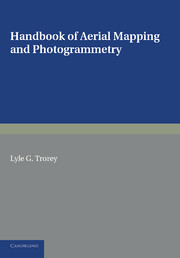Book contents
- Frontmatter
- Dedication
- FOREWORD
- PREFACE
- Contents
- LIST OF TABLES
- Bibliography
- Notation
- CHAPTER 1 PERSPECTIVE PRINCIPLES
- CHAPTER 2 MEASUREMENT OF ANGLES FROM OBLIQUES
- CHAPTER 3 PERSPECTIVE GRID AND FOUR-POINT METHODS
- CHAPTER 4 MEASUREMENT OF HEIGHT FROM A SINGLE OBLIQUE
- CHAPTER 5 VERTICALS: FUNDAMENTAL CONSIDERATIONS OF COVER, PARALLAX AND STEREOSCOPY
- CHAPTER 6 PARALLAX AND ELEVATION CALCULATIONS
- CHAPTER 7 RADIAL-LINE TRIANGULATIONS, GRAPHICAL AND MECHANICAL
- CHAPTER 8 RECTIFICATION MEANS
- CHAPTER 9 SUBDIVISIONS OF AN AIR SURVEY MAPPING OPERATION
- CHAPTER 10 PRINCIPLES OF STEREOSCOPIC PLOTTING INSTRUMENTS
- CHAPTER 11 THE MULTIPLEX PROJECTOR
- APPENDIX 1 STANDARD MAPPING PROCEDURE ROYAL CANADIAN ENGINEERS
- APPENDIX 2 MULTIPLEX AND STEREOPLANIGRAPH: CONSIDERATIONS GOVERNING MINIMUM CONTOUR INTERVAL
- APPENDIX 3 THE KELSH PLOTTER
- INDEX
APPENDIX 1 - STANDARD MAPPING PROCEDURE ROYAL CANADIAN ENGINEERS
Published online by Cambridge University Press: 05 June 2016
- Frontmatter
- Dedication
- FOREWORD
- PREFACE
- Contents
- LIST OF TABLES
- Bibliography
- Notation
- CHAPTER 1 PERSPECTIVE PRINCIPLES
- CHAPTER 2 MEASUREMENT OF ANGLES FROM OBLIQUES
- CHAPTER 3 PERSPECTIVE GRID AND FOUR-POINT METHODS
- CHAPTER 4 MEASUREMENT OF HEIGHT FROM A SINGLE OBLIQUE
- CHAPTER 5 VERTICALS: FUNDAMENTAL CONSIDERATIONS OF COVER, PARALLAX AND STEREOSCOPY
- CHAPTER 6 PARALLAX AND ELEVATION CALCULATIONS
- CHAPTER 7 RADIAL-LINE TRIANGULATIONS, GRAPHICAL AND MECHANICAL
- CHAPTER 8 RECTIFICATION MEANS
- CHAPTER 9 SUBDIVISIONS OF AN AIR SURVEY MAPPING OPERATION
- CHAPTER 10 PRINCIPLES OF STEREOSCOPIC PLOTTING INSTRUMENTS
- CHAPTER 11 THE MULTIPLEX PROJECTOR
- APPENDIX 1 STANDARD MAPPING PROCEDURE ROYAL CANADIAN ENGINEERS
- APPENDIX 2 MULTIPLEX AND STEREOPLANIGRAPH: CONSIDERATIONS GOVERNING MINIMUM CONTOUR INTERVAL
- APPENDIX 3 THE KELSH PLOTTER
- INDEX
Summary
Introduction
There are two characteristics which air survey personnel must have, and must use at all times. These are common sense and lack of imagination. We take the view that it is better to have a particular area of a map blank than to have it wrong. Mark the blank ‘gap’. Mistakes in a civilian mapping project may cost somebody money. Mistakes in a military map may jeopardize the success of a whole operation with the gravest consequence in wastage of manpower and material.
Mapping from air photographs is not difficult. Although the metamorphosis from the blank paper to the finished three-colour sheet may seem complex and mysterious, the whole may be broken down into a number of unit operations, each of which is simple, and easy to understand. This is a specific contact scale mapping procedure at 1 : 25,000 (about 2 ½ in. to 1 mile). The principles, however, have application to mapping at other scales.
Mapping at 25,000, as performed by the Royal Canadian Engineers, is divided into seven major parts. These are horizontal control, interpretation, compilation of the planimetric interpretation into a controlled manuscript which we call the pencil compilation, topography, fair-drawing on pulls of the pencil compilation, photography and proving, and, finally, proof-reading and photo-writing.
Simple photogrammetric apparatus facilitates many of these operations, and for each there is laid down a standard procedure, a drill, setting out in detail how and in what order each sub-operation is to be performed. These drills are based upon a considerable experience of mapping of this kind, but nevertheless are not to be considered as immutable—since all progress involves change.
The operation as a whole is designed to take advantage of the benefits resulting from subdivision of labour: reduction of training period, development of high individual skill, and reductions in both the total hours and the elapsed hours per sheet. Such a system requires internal organization which ensures that all parts of the work are, at all times, in phase. It is merely the application of well-known principles of production engineering to a factory designed to build maps.
- Type
- Chapter
- Information
- Handbook of Aerial Mapping and Photogrammetry , pp. 148 - 171Publisher: Cambridge University PressPrint publication year: 2013



